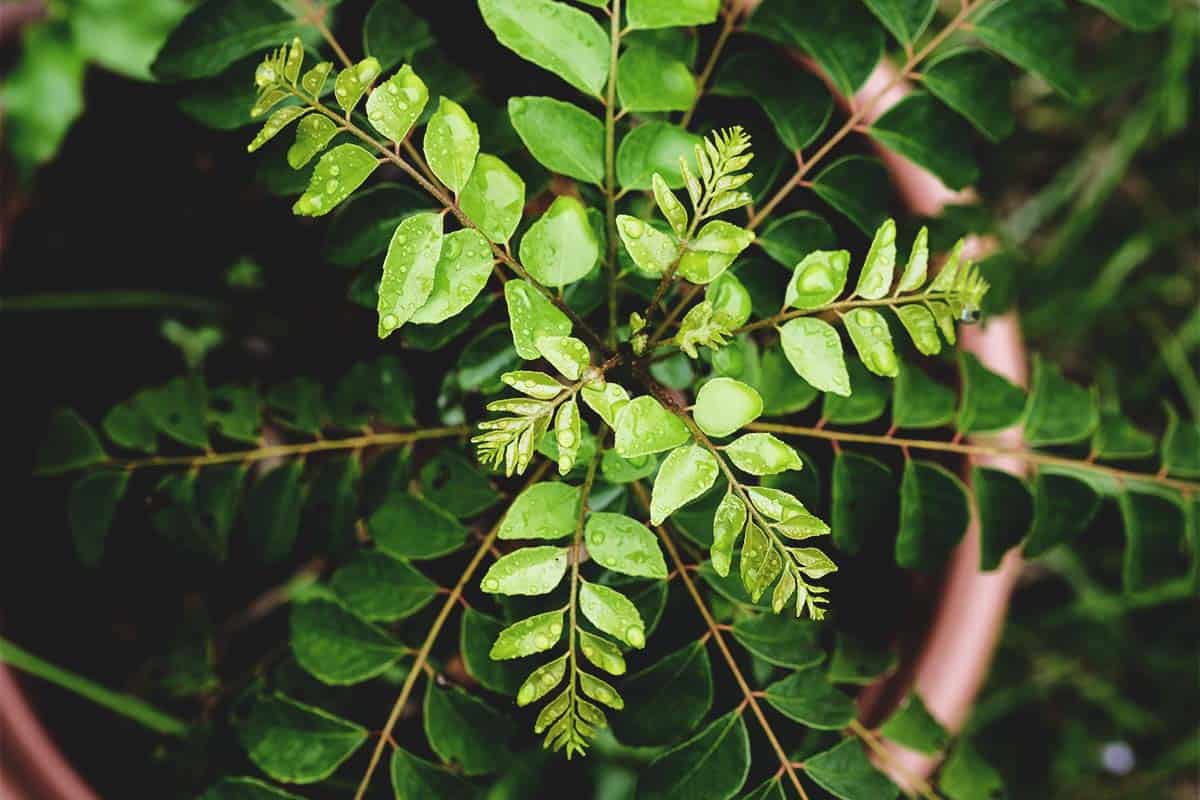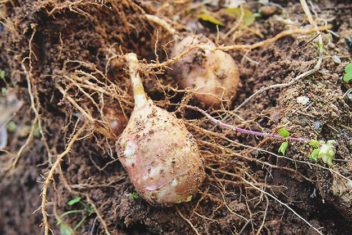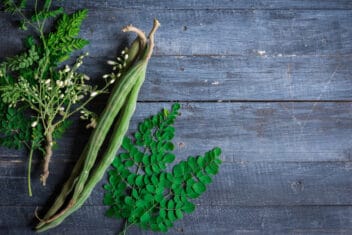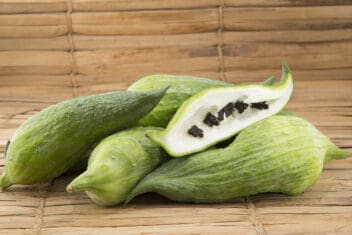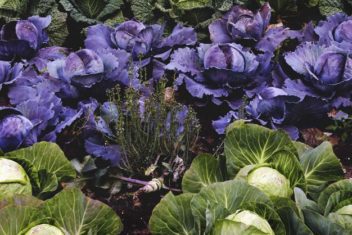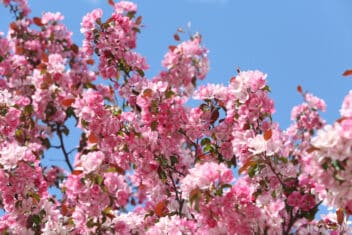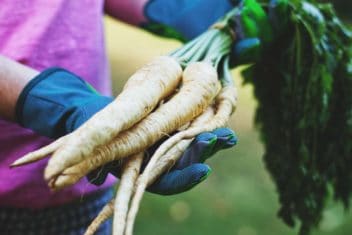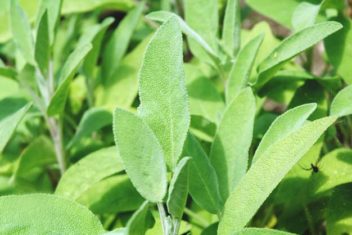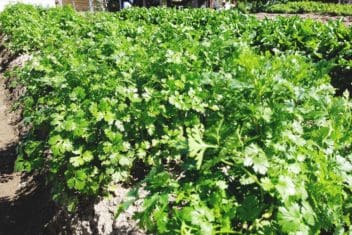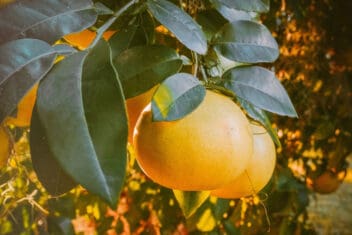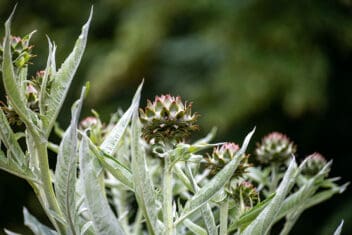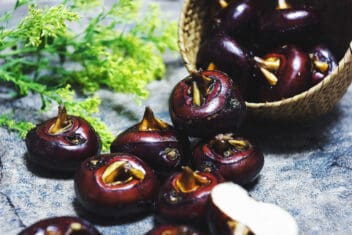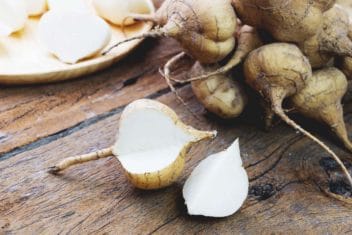I always wanted to try curry leaves, but I don’t have easy access to it at my local market. So I went on the hunt for a curry leaf plant I could try growing. That’s how serious I was about giving this ingredient its due.
I’m glad I did. The flavor is incredible. Sauteed in oil, the leaves have a crunchy texture akin to kale chips, and they offer up a burst of freshness you can’t achieve with any other ingredient.
Ready to learn how to grow this tasty green?
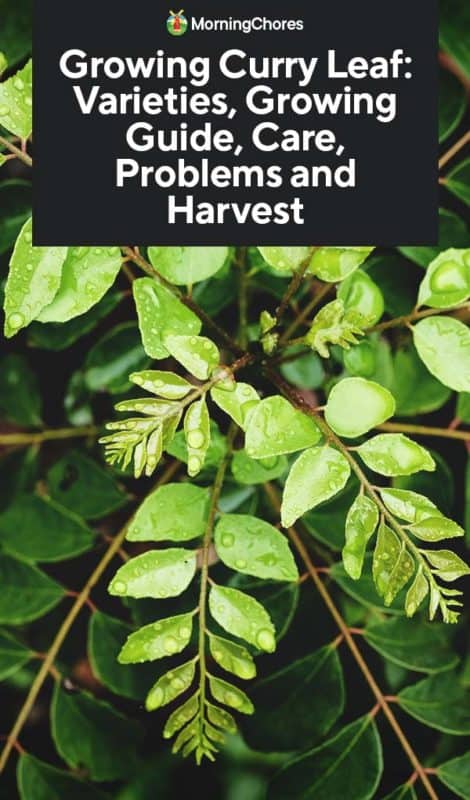
Curry Leaf versus Curry Powder versus Curry Plant
First off, let’s clarify the difference between curry powder, the curry plant (Helichrysum italicum), and the curry leaf plant (Murraya koenigii).
Neither curry plants nor curry leaf plants are used to produce curry powder. The orange spice, oft-used to flavor southeast Asian dishes, is typically made from a mixture of spices like coriander, cumin, ginger, and mustard. It gets its orange hue from turmeric.
The curry plant does give off a strong aroma that’s similar to curry powder, but it’s not edible. It’s similar in appearance to lavender or rosemary, with shrub-like growth and spiky little leaves.
The curry plant, while not suitable for eating, does have valuable medicinal qualities. Its essential oil has anti-inflammatory properties and is helpful for soothing chapped, dry skin, or open wounds.
Curry plants are perennial, but in zones below 7, they are usually grown as annuals. They fare best in full sun (but tolerate partial shade).
Curry leaf plants aren’t used as an ingredient in curry powder, and they don’t taste anything like that bright orange spice at the recesses of your cupboard.
They’ve often used as an ingredient in curries, but they don’t have the aroma or flavor that might come to mind when you think of curry. Curry leaves are usually used as an aromatic but are indeed edible if fried up.
Curry Leaf Varieties

There are three distinct types of curry leaf plants and they are differentiated mainly by their size. The curry leaf tree—the largest of the three varieties—grows up to 15 feet tall and is the typical source for store-bought leaves.
Dwarf and miniature varieties are better suited for at-home growing, especially if you live in a cold climate. Some dwarf curry leaf plants, however, aren’t the ideal plant for culinary use because they have leaves with a less impressive flavor profile.
Miniature plants tend the have the best flavor, but they’re the slowest growing.
How to Plant Curry
Curry leaf plants are hardy between zones 8 to 12. If you live in a cooler climate, you can grow them in a container and bring them indoors in the winter.
You can also grow curry leaf plants entirely indoors if you have a sunny spot.
Sun Requirements
Curry leaf plants require plenty of sunlight to thrive and prefer heat to cool conditions, but young plants should be kept out of direct sunlight to prevent the burning of leaves.
Soil Requirements
Plant your curry leaf plant in an area with well-draining soil. Aim for a pH between 6.0-7.0. Enrich the soil with plenty of organic matter before planting.
When to Start
If you’re planting indoors, timing doesn’t matter much.
If you’re planning on growing curry outdoors, start plants indoors 7-8 weeks before the last frost date. Then, transplant them outdoors 1-2 weeks after the last frost.
Be sure to harden them off for 1-2 weeks before planting.
Starting Curry Plants
You can start curry leaf plants from seed, but the easier way is to propagate a plant through cuttings.
Grab a stem from a friend with an established plant and strip the stem of its lower leaves. Then, stick the stripped part of the stem into your growing medium. Ensure the soil is kept moist, and the plant is not exposed to frigid temperatures and wait.
With proper attention and care, the plant should take root within a few weeks.
Growing curry from seed is infinitely more challenging—a lot like growing avocado—as seeds (really the pit of the plant’s fruit) need to be kept consistently moist and at a consistent temperature of around 68°F for success.
Seeds often fail to germinate, though, even when they’re fresh.
To plant seeds, remove the hard outer shell. Plant them 1-inch deep and plant lots of seeds because they have a low germination rate. Make sure seeds are fresh by purchasing from reputable sources.
Spacing
These plants need plenty of room. If you’re growing curry directly in the soil, plant them 8-16 inches apart.
Container Planting
Good news! It’s easy to keep a curry plant in containers, either indoor or out. This is a good option for people who live in areas with a pronounced frost period.
Plant curry leaf plant in a container so that it’s easy to move the plant indoors when the weather cools down.

One plant per container is sufficient. Small curry leaf plants don’t require unusually large containers, but over time you’ll need to upgrade the plant’s pot to accommodate its growing root system.
Older, larger plants should be placed in containers that hold at least 30 gallons of soil.
How to Care for Curry
Once your plant has rooted or sprouted, the care required is relatively minimal. Curry leaf plants are fairly low-maintenance and easy to care for.
- Watering: Curry leaf plants don’t require a lot of water and are partially tolerant of drought conditions. Overwatering is a likely death sentence for a curry leaf plant. Allow the soil to dry out completely between watering.
- Weeding: You shouldn’t have to weed your plant often if it’s in a container and inside your home. Outside, keep weeds away to prevent disease.
- Fertilizing: Regular feedings with an organic fertilizer will ensure your plant thrives throughout the year. In the summer, feed more often. Give a high nitrogen fertilizer every 5 to 6 weeks.
- Pruning: Pinch off the tips of branches to encourage a bushier plant and denser growth. Pruning is done through harvest. Harvest leaves throughout the year to ensure the plant continues to produce foliage. Remove any flowers you see, so the plant doesn’t put its energy into fruit and flower production.
Problems and Solutions to Growing Curry
While the disease is rare, there are a few that can ravage your curry leaf plant, including powdery mildew and curry leaf spot.
The curry leaf plant is one of the rare plants that doesn’t experience too many problems with pests. In fact, it often acts as a pest deterrent because of its strong emanating odor.
There are a few pests that may attack your plants, including scale, aphids, mealybugs, and citrus psyllid. Insects that are likely to attack your lemon and orange trees are also capable of infesting your curry leaf plant since curry leaf plants belong to the citrus family.
Aphids and Scale
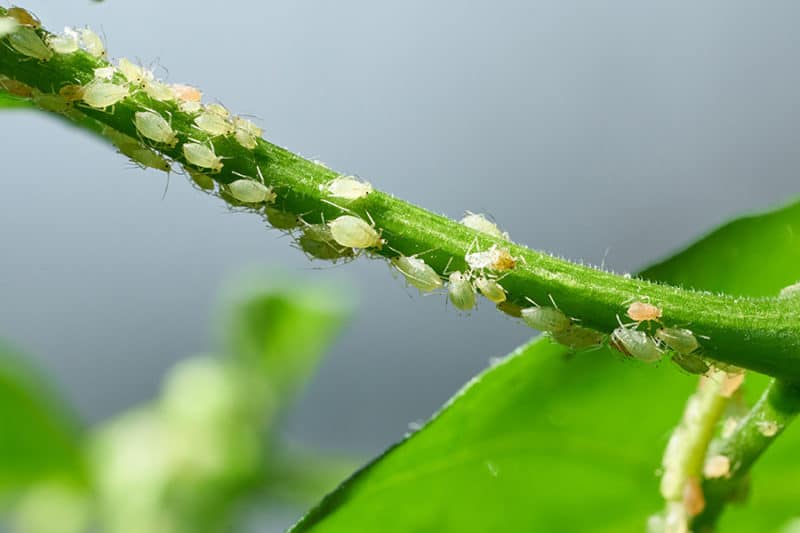
Scale insects and aphids both harm plants by sucking fluid from plants. As the little bugs feed on foliage and sap your plant of life, leaves yellow, wilt, and fall off.
Neem oil is a helpful tool for combatting both scale and aphids. Introduce predator insects (e.g., ladybugs) to help control pest populations.
You can learn more about dealing with aphids by reading our guide.
Citrus Psyllids
Citrus psyllids are another potential curry leaf plant pest. They munch on leaves and stems of plants.
To deal with psyllids, you’ll need to be heavy-handed. An infestation is tough to combat with traditional pest control methods. Sprays and pesticides won’t do much good, so you’re better off focusing on prevention with this particular pest.
Mealybugs
Mealybugs are soft-bodied insects usually surrounded by a fuzzy material where they hang out on plants, which is usually on the stems.
The first step is to wash your plants to rinse away the pests. Then, use an insecticidal soap or neem oil to kill them off. Introducing and encouraging natural predators is the best way to prevent a mealybug infestation.
Leaf Spot
Leaf spot is usually a symptom of pest infestation. As the name implies, it looks like spots on the leaves of plants, caused by bacteria or fungus, often carried by pests like aphids. These spots can grow together and cause leaves to die off.
You can spray plants with a 1:10 combination of baking soda and water. You can also apply neem oil. Apply fungicides at the first sign of the disease. This won’t cure it, but it will prevent the spores from germinating.
Powdery Mildew
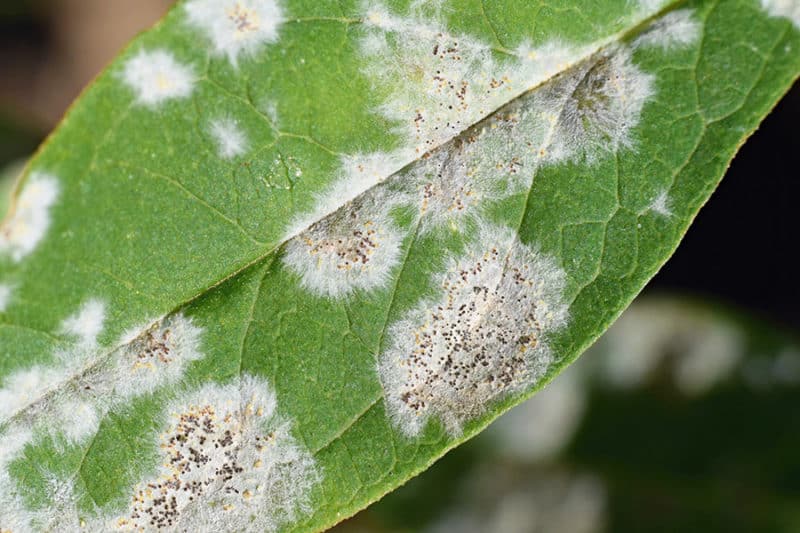
Powdery mildew is a fungal disease that primarily affects the foliage of a plant, producing white spots with a powdery appearance. Use fungicides to attempt to rid your plant of the fungus.
If this is not effective, you may have to destroy the plant entirely as the disease can readily spread to other plants and, in time, is likely to kill the host plant anyhow.
Best Companion Plants for Curry
Curry leaf is an excellent companion plant due to its strong aroma. The noticeable odor is a deterrent for many pests. If you’re having a problem with aphids, mealybugs or other small sap-sucking insects, consider planting zinnias and other flowering plants nearby to encourage the presence of predator bugs.
You can also plant with coconut, pulses, or nasturtium.
Don’t plant with potatoes.
Indoors, curry leaf is often kept alone in its container, so companion planting isn’t something you need to consider if your plant is hanging out solo in the corner of your kitchen.
How to Harvest, Use and Store Curry
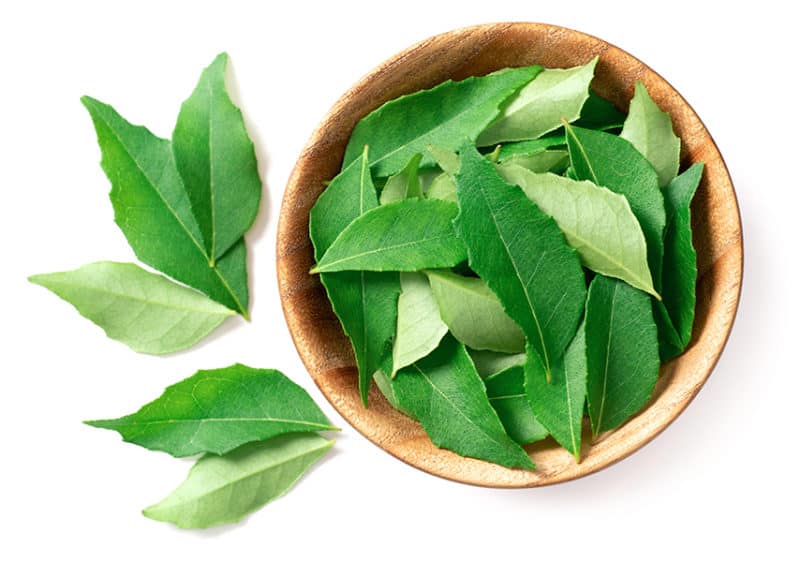
I was first introduced to the magic of curry leaves last fall when I joined a cookbook club and began cooking through Indian-ish by Priya Krishna. It now has a permanent place in my kitchen next to the stove.
Without a location close-by where I could source fresh curry leaves, I was stuck using unsatisfying substitutes or omitting them from the recipes altogether. Then, a friend, who had also joined the group, brought me some that she had gotten on her recent shopping trip.
I was addicted. Now I use them in my cooking all the time.
You can use it to make curry rice or in a sauce for meat. This spiced vegetable gratin will blow your mind.
Pick leaves frequently to encourage a bushy growth habit and leaf production. I’ve had success keeping fresh leaves in a ziplock for about a week and a half.
It’s also possible to dry the leaves for long-term storage. When dried, leaves are used much as you would bay leaves. I much prefer the leaves in their fresh form, though.
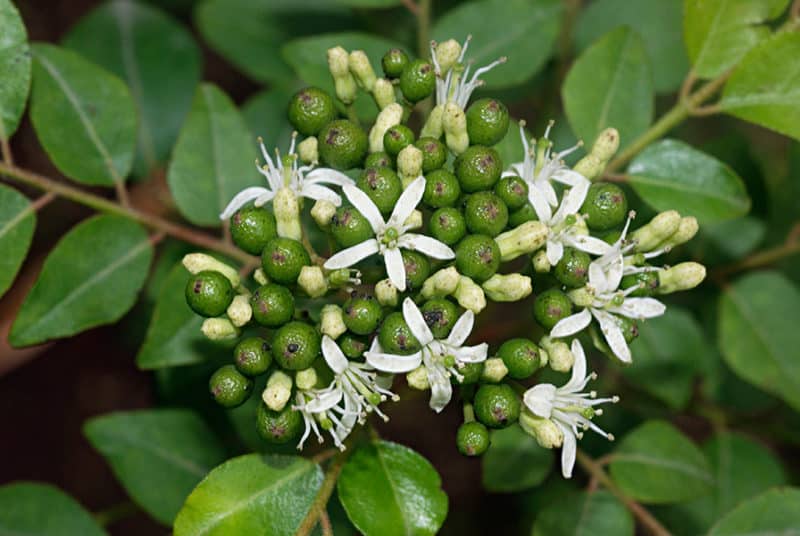
Note that the berries that form on the curry leaf plant are toxic and you shouldn’t eat them.
Now’s the Time to Start Growing Curry
There aren’t enough people growing curry in the garden. It’s such a delicious treat that deserves more attention in home gardens.
Plus, it’s nice having a plant in the garden that’s more of a pest deterrent than a victim of pests and diseases.
Be sure to let us know how you use your curry leaves! Leave your ideas in the comments below.
